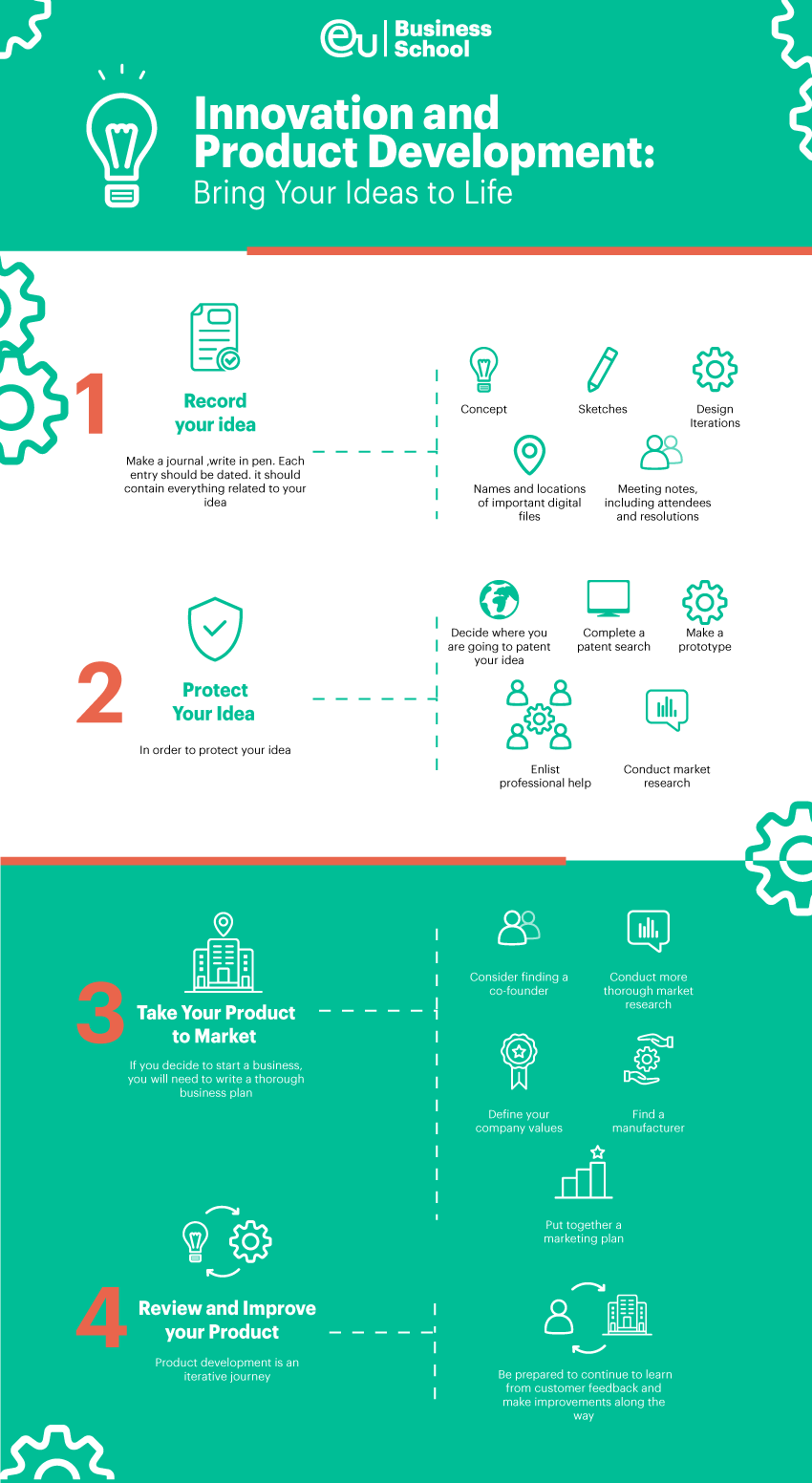Famous inventors from Johannes Gutenberg, who invented the printing press, to Tim Berners-Lee, who gave us the internet, have transformed the way we live. If you’ve had an innovative idea that offers something new and needed, it’s worth taking the journey to transform it into a reality. But having the idea is just the beginning; bringing it to light is where it gets complex.
When it comes to product development, there are a specific set of steps that you will need to follow in order to take your lightbulb moment to market. Here, we will take you through them one by one so that you can see your brilliant product idea come to life.

1. Ideation: Record Your Idea
The first thing any inventor needs to do is record their idea. The best place to do this is in an inventor’s journal. You can buy specifically designed journals for this purpose, or you can buy a notebook from your local newsagent, just make sure that it is bound and has numbered pages. The idea is that this journal will become a trustworthy piece of evidence (if that’s ever required) that proves your idea is yours. So, write in pen and make sure that the pages cannot be removed. Each entry should be dated. The journal should contain everything related to your idea, including:
- The concept
- Sketches
- Design iterations
- Names and locations of important digital files
- Meeting notes, including attendees and resolutions
When you start your journal and write down your idea, get a witness to sign it. That way you have another person who can verify that the idea is yours. If your idea is a brilliant one, then others will try to steal or copy it. If that happens, you will need to stand up in court and prove that you had the idea first. It is a notoriously difficult argument to win, which is why it is imperative to record everything scrupulously. It might seem like a lot of arduous work now, but it will save you a lot of pain further down the line.
2. Intellectual Property Rights: Protect Your Idea
You’ve probably heard about trademarks, patents and copyrights. Each of these provides protection to innovators and entrepreneurs and forms part of intellectual property law. It’s a complex field but in the case of protecting your product idea, you only need to worry about obtaining a patent.
However, it is helpful to understand the difference. Copyrights protect the creation of artistic works such as a piece of literature, a symphony or a piece of code, whereas trademarks protect brand identity, company names and logos. Patents provide protection for inventions including new processes, machinery, materials and products, as well as new species of plants! They key to getting a patent is by having an idea that is both new and unobvious.
Having recorded your idea, you are already on the way to getting your patent. These are the next steps you will need to follow:
- Decide where you are going to patent your idea: almost every country has its own patent law and a patent is only valid in the country in which it is granted. If you’re planning to go global with your product, you might wish to file for patents in several countries. Start with the USPTO, which covers the U.S.A and the EPO which covers all 26 member states of the European Union. Don’t go overboard here, remember that filing for a patent and then maintaining it costs money, something that’s often in limited supply at the start.
- Complete a patent search: check the database of each of the patenting services you want to file with, to make sure that no one else has patented the same invention.
- Make a prototype: this will help you to work out any kinks in your idea and ensure that you are submitting a patent application for the fully formed idea. Amending the patent later down the line will cause headaches and could risk the ownership of your invention.
- Conduct market research: you need to check it is all worth the effort. Will people buy your product? Are other people (apart from your family and close friends) as enthusiastic about the solution you’ve created as you are? Does your product have a USP compared to other, similar items on the market? Your prototype could come in useful at this stage. Remember, it is vital to make sure you are protecting a viable idea as only five percent of patents ever make any money.
- Enlist professional help: while you can fill out the patent paperwork yourself, it is incredibly important to work with a patent professional to check everything before you file it. As we’ve already mentioned, if your idea is a good one people will try to find loopholes in the law to claim it as their own. Paying a professional patent lawyer at this stage will save a lot of time and money later. Look for someone who is registered with the Patent and Trademark Office and has the expertise needed to fully understand your invention.
3. Start Selling: Take Your Product to Market
Now you have ensured the viability and ownership of your idea, you’re ready to embark on the next stage in your journey: taking your product to market. Again, there are several steps which you need to follow to make this happen.
First, decide if you want to start a business to sell your product direct to consumers, or if you want to license your idea to another company to produce and sell. Each route has its advantages. If you license the idea, you will only receive a small percentage of the profits, but you won’t incur the cost of setting up a business. You should only start a business if that challenge appeals to you, and if you feel you have the skills needed to do so. Being an entrepreneur is hard work, although incredibly rewarding. If you think you might be more of an inventor than a founder, find a company you can work with you get your product to market.
If you decide to start a business, you will need to write a thorough business plan. This is essential for gaining investment. It will also provide a helpful roadmap that will guide you on the journey ahead.
Each of the following steps will provide the much-needed detail for your plan.
- Consider finding a co-founder: Working with someone whose skillset complements your own can help your business to thrive; having two founders has been proven to increase the chance of a startup’s success. What’s more, it has the added benefit of making the entrepreneurial struggle a little less lonely.
- Conduct more thorough market research: look at other products on the market and the price they retail at; this information will be useful when it comes to putting together your financial forecast. Hold focus groups to gain feedback from your target audience; this will inform your marketing plan.
- Define your company values: it’s important to determine what your brand stands for as this will underpin all your business decisions from here on in. For example, do you care about sustainability? This will affect the materials you choose to use for your product, and how and where you manufacture and distribute it. The values you choose will also impact your audience; consumers are increasingly looking for ethical, local and environmentally friendly products. Investors will also be keen to understand the vision and mission of the company that they are considering supporting.
- Find a manufacturer: choosing the best company to manufacture your product is a big decision. Manufacturing market places like MFG and GSS are a great place to start your search, but first there are several factors that you need to consider.
- Values: the values that your business holds at its core will impact your decision on where, how and what to use to manufacture your product. Hold these in mind as you consider the subsequent factors.
- Location: working with factories at home or overseas has advantages and disadvantages. Often, producing an item in China or Vietnam, for example, can bring down costs significantly. However, it can bring with perceptions of lower quality. In addition, the distance, time difference and language barrier can make it hard to ensure the quality of your product and that it is delivered on time and to spec. Lastly, the intellectual property protection for your product is likely to be higher if you manufacture it at home, rather than abroad.
- Expertise: you should seek a manufacturer that is experienced at working with the materials your design requires and that has produced similar items before. A manufacturer who knows your market well will be an asset.
- Reputation: which other brands does the manufacturer work with? Have they got a good reputation? Doing your homework at this stage is well worth the extra effort. You want to build a strong working relationship with a manufacturer who is invested in your success and is committed to helping you get there.
- Cost: this should not be a deciding factor; you should seek quality. However, make sure you get detailed financial information for the manufacture and distribution of your product, as this will need to be included in your business plan.
- Put together a marketing plan: this step is vital to making sure your idea doesn’t just gather dust on the shelf. You need to do the following:
- Define your target audience and be as specific as you can.
- Decide on the channels you will invest time and money in to reach your audience. Make data driven decisions and prioritize SEO and email marketing; these are the most effective methods and will reach any audience if done well.
- Tell a story about your product to captivate your audience. Your company values are essential to doing this effectively. As Simon Sinek encourages, start with why.
The information that you have gathered by following the steps above should be collated into a detailed business plan. A great business plan will:
- Demonstrate your knowledge of your industry and audience.
- Explain how your company will work.
- Detail marketing and sales strategies.
- Describe your product.
- Include financial forecasts and outline the funding you need.
Once your business plan is complete you will be ready to find investment and get started!
4. Post-launch Strategies: Review and Improve your Product
Turning an idea into a reality can be a daunting process to embark on but remember, product development is an iterative journey. You shouldn’t aim for perfection in the first product you create, but to produce something that solves the challenge you wanted to solve when you first had that lightbulb moment. Be prepared to continue to learn from customer feedback and make improvements along the way. Working collaboratively with customers has the added advantage of building brand loyalty.
The first step is to turn your great idea into action. Once you’ve made that step, the rest will fall into place.
Learn to Launch Your Product
At EU Business School, we can equip you with the tools, knowledge and mindset you’ll need to turn a great idea into a runaway success.










